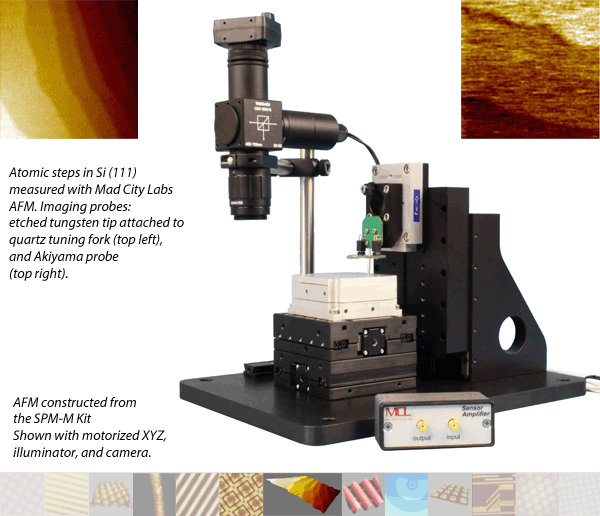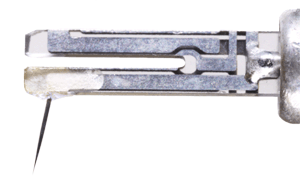400-6699-117转1000
咨询列表
北京欧兰科技发展有限公司
您好,欢迎您查看分析测试百科网,请问有什么帮助您的?



诚信认证:
工商注册信息已核实! 扫一扫即可访问手机版展台
扫一扫即可访问手机版展台
| 参考报价: | 面议 | 型号: | SPM-M |
| 品牌: | MCL | 产地: | 暂无 |
| 关注度: | 1044 | 信息完整度: | |
| 样本: | 典型用户: | 暂无 | |
| 价格范围 | 10万-50万 |
400-6699-117转1000
![]()

The SPM-M Kit combines the MadPLL® instrument package with Mad City Labs high resolution nanpositioning systems to form a high performance, closed loop, scanning Akiyama probe or tuning fork AFM. The seamless integration of hardware combined with the built-in automated control of MadPLL® means that you can concentrate on getting results, not tweaking parameters. Applications for the SPM-M Kit include nanoscale characterization and nanoscale fabrication applications such as optical antennas, nano-optics, semiconductors, data storage, and more. The SPM-M Kit is ideal for research and teaching laboratories offering high performance, versatility, simplicity and excellent value.At left: Schematic of a typical AFM instrument based on the SPM-M Kit.The SPM-M Kit includes: MadPLL® Instrument Packagedigital phase lock loop (PLL) controllerprobe mounting boardsfive quartz tuning forksNano-SPM200 nanopositioning stage (XY)Nano-OP30 nanopositioning stage (Z)3 axis closed loop Nano-Drive® controllerZ axis open loop/close loop switch (OCL option)AFMView™ SoftwareAFMView™ TutorialAdapter plate between probe mount board and Nano-OP30Application note: "AFM Kit with manual positioning"Application note: "Tungsten tip etching station"MadPLL® is a powerful instrument package that allows the user to create an inexpensive, high resolution resonant scanning probe microscope using Mad City Labs nanopositioning systems. The MadPLL® package includes a digital phase lock loop (PLL) controller, software, sensor amplifier board, and resonant probe mounting board. MadPLL® includes five (5) each of the vertical, horizontal, Akiyama, and blank probe boards. In addition, each unit is shipped with five (5) tuning forks. Additional probe boards and tuning forks can be purchased separately.Available options:Double walled isolation enclosureCoaxial illuminatorMotorized or manual Z-axis approachMotorized or manual XY-axisCameraSPM baseplateSPM Etch KitNot included: These items are described in the application note and are listed in the Bill of Materials (BOM)L-BracketFasteners or clampsRecommended additional items:Vibration isolation table |
|
Instant AFM - just add science!
|
Seeing is Believing!
|
 An etched tungsten tip glued to a quartz tuning fork.
|
Additional Information | ||
MadPLL® Brochure | Laser Focus World Article  NANOPOSITIONING: Piezo­electric nano­positioners forge low-cost atomic force microscope | AFM Video Tutorial |
MadPLL® Sensor Probe Board Drawing  | Application Notes: SPM-004 "Building an AFM with motorized XYZ and camera" | |
Related Products |
MCL原子力显微镜SPM-M套件信息由北京欧兰科技发展有限公司为您提供,如您想了解更多关于MCL原子力显微镜SPM-M套件报价、型号、参数等信息,欢迎来电或留言咨询。
注:该产品未在中华人民共和国食品药品监督管理部门申请医疗器械注册和备案,不可用于临床诊断或治疗等相关用途

